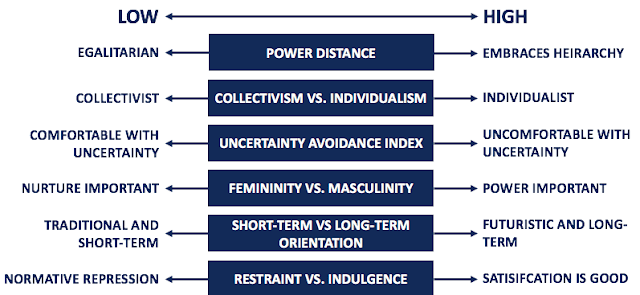Hofstede's Cultural Dimensions Theory
Hofstede had to manage a global team with people from
different countries and cultures. So, he knew that the language and the culture
could be a problem to have a good communication between the members of the team,
and he wanted to discover the differences between countries to understand the
different behavior of people from each country and to do his work effective. He
observed the way of working of employers from a specific company in more that
50 countries, and he distinguished 6 dimensions that englobe different culture
traits:
- Power Distance Index: this refers to the degree of inequiality that exists between people with and without power.
- . Individualism vs Collectivism: it considers the degree to which societies consider the goals like personal goals or team goals.
- . Uncertainty Avoidance Index: it describes how people react when is in anxiety situations. People with high score in that dimension are so stressed when they are in uncertain situations, and if they think they can’t get something, they stop trying; but people with low levels are more relaxed.
- . Masculinity vs Femininity: it refers to the distribution of roles between men and women. If the score of masculinity is high, the society looks competitive; but if it has high levels in femeninity, it looks more emotional.
- . Long-Term Orientation vs Short-Term Orientation: it refers to the time horizon people in a society display. Countries with a long-term orientation focus their goals on the future, and they get short-term goals to get the main goal; however, countries with a short-term orientation focus their goals on the near future, giving more importance to live the present.
- . Indulgence vs Restraint: it refers to how a society control it impulses and desires. Countries with high socre in that dimension are more emotional and allowed feedback and free gratification related to have fun; but countries with low levels suprress gratification of needs and have stricted rules.
Finland
If we analyze Finnsih culture
following this six dimensions we see that Finland is a country where control is
disliked and power is descentralized ; it is an individualism society, where
the mates of a group are expected to take care of themselves and they focus in
their own goals; it is considered a Feminine society, so the focus is on
working in order to live; they avoid uncertainty, they get stressed when are in
different or weird situations; they focus on quick results and they don’t save
for the future; and finally, they have a positive attitude and have a tendency
towards optimism.
Spain
However, if we analize Spanish
culture, we observe that is a country where power is focus in one person who
controles everything; it is collectivist and give so importance to
communication and emotional health; it is the second noisiest country in the
world; it has also so many rules and Spanish people get stressed in weird
situations, like to live the moment, and they are a bit pessimist.
How can I adapt myself to Finnish
culture?
If we compare both culures we can
see that they are not very different, but there are some traits whose
differences are so important. For example, Spanish people are so noisy and they
used to be very sociable, and it can be perceived as aggressive by countries
like Finland. Further, in Spain the power is centralized in only one person, so
for a Spanish person is a bit difficult to work in a team where everybody can
lead.
So, to make my work effective I
must be less talkative or emotional and I must try to lead in a cooperative
way. This model is so effective to know how to actue in a different country!






Comentarios
Publicar un comentario